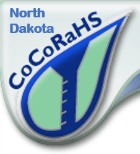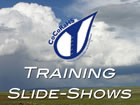Welcome to CoCoRaHS in North Dakota
The Community, Collaborative, Rain Hail & Snow network (CoCoRaHS) launched in North Dakota on November 1, 2008. CoCoRaHS is a network of volunteers from all states in the US and some neighboring countries. The trained volunteers measure precipitation from standardized equipment and record the results daily on the CoCoRaHS web site - www.cocorahs.org
Installation, Recording Data, Snow Measurements, and Rain Measurements - Information Packet
These observers will measure rainfall, snowfall and snow depth as part of the Community Collaborative Rain, Hail and Snow (CoCoRaHS) Network. Some observers also measure the water equivalent of the snow after it melts.
North Dakota has been collecting precipitation (rainfall and snowfall) data since the early 1900s in most places. When farmers, engineers and weather and river forecasters ask for precipitation data for a given location, that information comes mostly from volunteer observers.
“Now is your chance to provide that data and be a part of the state’s climatological history,” Akyuz says. “It’s fun, easy and only takes five minutes a day.”
North Dakota has more than 300 such volunteer precipitation observers.
“However, it is not nearly enough,” Akyuz says. “We need as many volunteer observers as possible around the state to help forecast flood potential, as well as drought assessments. Don’t worry if you do not know how to do all that. We have a lot of training materials for you to become an observer. All you need is an interest in weather to participate in the program and a cylindrical rain gauge.”
In your neighborhood, volunteers of all ages and backgrounds already may be measuring precipitation in their own backyards as part of CoCoRaHS Network, which has grown to more than 15,000 volunteer observers covering every state.
Data from CoCoRaHS Network volunteers routinely are being viewed and used by many professions and organizations, including meteorologists, hydrologists, emergency managers, city utilities, insurance adjusters, agribusinesses, engineers, science teachers and the National Weather Service. Data are used for many applications, such as water resource planning, severe storm warnings, teaching earth science, predicting crop yields and assessing hail damage.
During March, the CoCoRaHS Network is running its annual competition among states called “CoCoRaHS March Madness.” The idea is to see how many new observers it can recruit in each state. North Dakota was the winner in 2010, 2012 and 2015.





